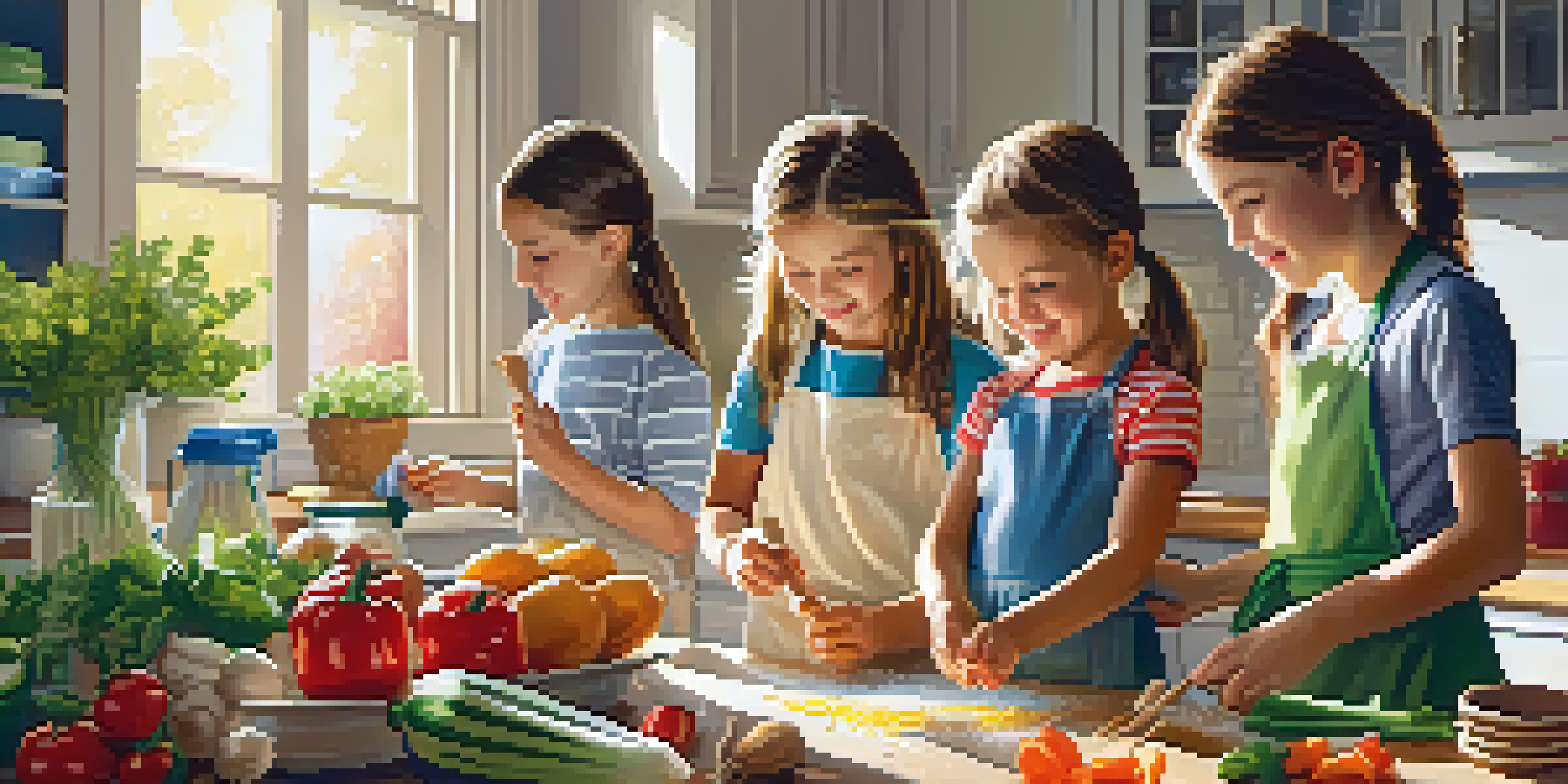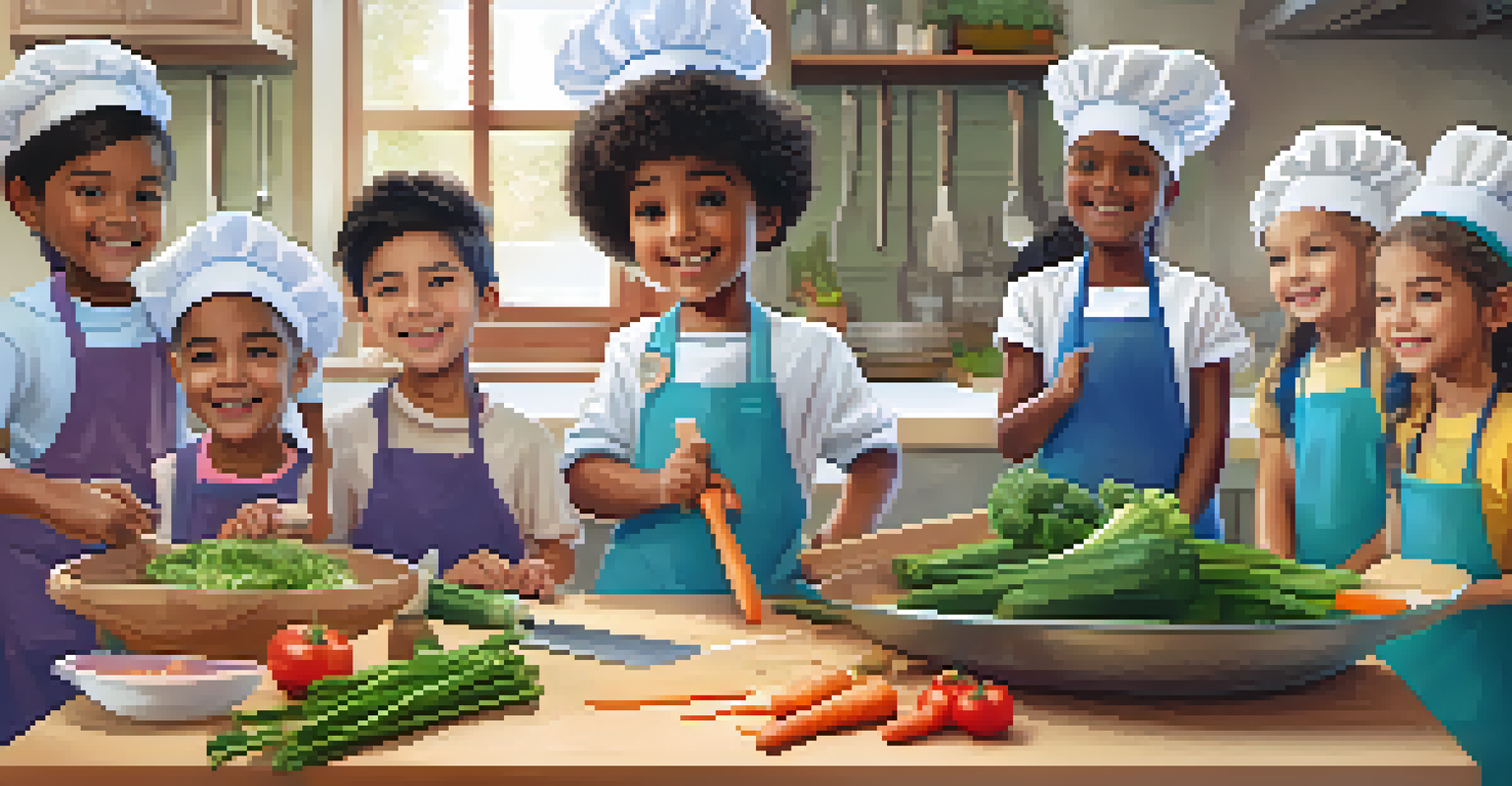Cooking with Kids: Fun and Healthy Classes for Families

The Joy of Cooking Together as a Family
Cooking together as a family creates lasting memories and strengthens bonds. When kids are involved in the kitchen, they learn valuable life skills while having fun. The process of preparing a meal can be a delightful adventure filled with laughter and teamwork.
Cooking is like love. It should be entered into with abandon or not at all.
Imagine your child proudly presenting their culinary creation, all while giggling at their flour-covered hands. This shared experience not only fosters creativity but also encourages communication and collaboration. Through cooking, families can explore new flavors and cultures right from their kitchen.
Moreover, cooking together offers a fantastic opportunity for kids to develop a healthy relationship with food. They learn where their meals come from and the importance of fresh ingredients, setting the stage for lifelong healthy eating habits.
Choosing the Right Cooking Classes for Kids
When considering cooking classes, look for options that emphasize fun and education. Classes designed for families often incorporate interactive elements that keep children engaged and excited. It’s essential to choose classes that cater to different age groups and skill levels to ensure everyone has a great experience.

A good class will not only teach cooking techniques but also include lessons on nutrition and food safety. This holistic approach helps children understand the significance of healthy eating while honing their culinary skills. Plus, seeing other kids having fun can inspire your child to join in.
Cooking Builds Family Bonds
Cooking together fosters lasting memories and strengthens family relationships through shared experiences.
Don't forget to check out local community centers or culinary schools that offer family-focused cooking sessions. These classes can be a wonderful way for families to meet others in their community while sharing a love for cooking.
Benefits of Healthy Cooking Classes for Families
Healthy cooking classes provide numerous benefits that extend beyond the kitchen. For one, they help families learn how to prepare nutritious meals that can prevent illnesses and promote well-being. Engaging kids in healthy cooking empowers them to make better food choices in the future.
Family meals are a reminder that we belong to one another.
Participating in these classes also teaches kids about the nutritional value of different ingredients. For example, they learn the importance of incorporating fruits and vegetables into their diets. This knowledge can lead to an increased willingness to try new foods and flavors.
Additionally, cooking classes can serve as a platform for family discussions about diet, health, and lifestyles. By sharing these experiences, families can effectively create a culture of health that lasts a lifetime.
Creating a Fun Cooking Environment at Home
Transforming your kitchen into a fun cooking environment can enhance the experience for everyone. Start by involving your kids in meal planning; let them choose recipes they want to try. This involvement makes them more excited about cooking and more likely to eat what they help create.
Consider setting up a dedicated cooking space where kids can easily access utensils, ingredients, and their own cooking tools. A space designed for creativity encourages experimentation, so don’t shy away from letting them mix things up a bit! After all, the best recipes often come from a little creative chaos.
Healthy Cooking Classes Matter
Engaging in healthy cooking classes empowers kids to make better food choices while learning essential culinary skills.
Lastly, remember to celebrate the process, not just the outcome. Whether the dish turns out perfectly or not, the laughter and learning moments shared in the kitchen are what truly matter.
Incorporating Educational Elements into Cooking
Cooking can be an excellent way to incorporate educational components into family time. For example, while measuring ingredients, kids can practice their math skills. Discussing the origins of different foods can spark interest in geography and culture.
You can also introduce science concepts by explaining how cooking techniques change the ingredients. For instance, why does bread rise? These discussions can make cooking not just a culinary activity but a learning experience that stimulates curiosity and critical thinking.
By blending fun and education, you’re nurturing a well-rounded understanding of food that can last a lifetime. This approach makes cooking a valuable and enriching family activity.
Making Cooking a Regular Family Tradition
To truly reap the benefits of cooking together, aim to make it a regular family tradition. Designate a specific day of the week for family cooking nights where everyone participates in meal prep. This consistency not only builds skills but also creates something everyone can look forward to.
Consider rotating who chooses the recipe each week. This way, every family member gets to share their favorite dishes while introducing new flavors to the mix. It’s a wonderful opportunity for kids to explore their culinary preferences and even learn about their family heritage through food.
Exploring Global Cuisines Together
Exploring various cuisines not only excites taste buds but also enriches children's understanding of diverse cultures.
Over time, these cooking nights can become cherished traditions filled with stories, laughter, and, of course, delicious meals. Families grow closer as they gather around the table to enjoy their culinary creations together.
Exploring Various Cuisines and Cooking Styles
Exploring various cuisines can add excitement and diversity to your family cooking adventures. Each week, you can focus on a different country’s cuisine, allowing your family to travel the world through food. For instance, one week could be Italian, filled with pasta and pizza, while another could be a spicy Mexican fiesta.
This exploration not only broadens taste buds but also invites discussions about different cultures and traditions. Kids can learn about the significance of certain dishes during celebrations or how various ingredients are grown and harvested. It’s a fantastic way to make cooking not just about meals, but about understanding and appreciating global diversity.

Moreover, trying out different cooking styles, like grilling, baking, or stir-frying, can keep the experience fresh and exciting. Each method teaches unique techniques and flavors that can inspire creativity in the kitchen.